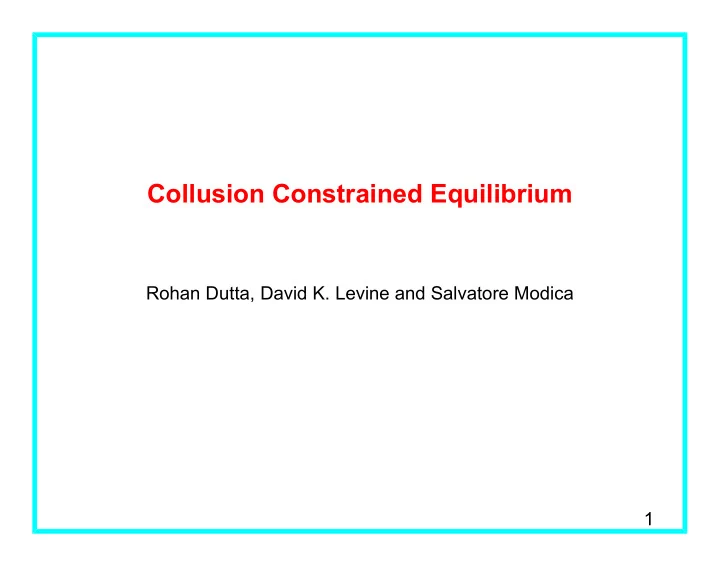

Collusion Constrained Equilibrium Rohan Dutta, David K. Levine and Salvatore Modica 1
An Example game with three players each has two actions or bimatrix payoffs player 3 plays players 1 and 2 are in a symmetric Prisoner's Dilemma game in which player 3 prefers that 1 and 2 both play player 3 plays players 1 and 2 are in a coordination game in which player 3 prefers that either 1 or 2 plays 2
Groups main question: what happens when players are exogenously partitioned into collusive groups? in the example an additional primitive: the first two players form a collusive group • they have a private randomizing device • they have agreed upon group objectives • agreements they reach are non-binding (only incentive compatible plans may be agreed to) 3
Analysis of Player 3 denotes the probability with which player plays denotes the correlated strategy of the group for illustrative purposes suppose that the randomize only between and so that is the probability of best response of then (player 3 plays ) player indifferent then (player 3 plays ) 4
Analysis of the Group: Correlation coordination game any value of is an equilibrium for the group pd only is an equilibrium for the group there are no binding agreements: the group must play an equilibrium correlated equilibria: and (player 3 plays ) and 5
The Paradox of 3 as King focus on the correlated equilibrium (also static Nash) payoffs very good for player 3 BUT: players 1 and 2 can collude and is incentive compatible given that 3 is expected to play : they would get 10 instead of 2 so no “collusion constrained” equilibrium with what about and the group should agree on , but then 6
No Strict Collusion Constrained Equilibrium the example is robust driven by the fact that the Nash correspondence fails to be LHC think like a behavioral economist we have a discontinuous change at when the group loses as an equilibrium but how can the group be dead certain of what is? suppose they agree on joint beliefs, but it is a random function of the “true” value of so if about half the time they think it is a bit less than ½ and about half the time they think it is a bit more than ½ so in effect they randomize between and and is the unique collusion constrained equilibrium 7
Basic Notions strict collusion constrained equilibrium each group maximizes its objective among incentive compatible correlated plans given the play of other groups group reservation utility : the worst of the best equilibria for nearby beliefs (when it is 2 in the example) collusion constrained equilibrium each group randomizes among incentive compatible correlated plans that give at least the group reservation utility given the play of other groups allows shadow mixing randomization onto plans that are not optimal but are no worse than the worst of the best equilibria for nearby beliefs collusion constrained equilibria exist and are correlated equilibria of the underlying game; strict collusion constrained equilibria are collusion constrained equilibria 8
Three Conceptual Experiments • Random Belief Equilibrium beliefs of each group are random. strict collusion constrained equilibrium exists and as the randomness vanishes the limit is a collusion constrained equilibrium • Costly Enforcement Equilibrium} groups can overcome incentive constraints with a costly enforcement technology (as in the peer monitoring model of Levine/Modica and the voting application of Levine/Mattozzi). strict collusion constrained equilibrium exists and as the costs become large the limit is a collusion constrained equilibrium • Leader/Evaluator Equilibrium leaders with valence give orders and are punished for orders that are not incentive compatible – Bayesian perfect equilibrium exists and as the valence vanishes the limit is a collusion constrained equilibrium 9
Lower Hemi-Continuity collusion constrained equilibrium is “big enough” but is it “too big?” in examples we see that the three different conceptual experiments can lead to different collusion constrained equilibria in the limit consider: belief perturbation, costly enforcement and a small perturbation of the group objective functions in the limit we get collusion constrained equilibrium AND every collusion constrained equilibrium arises as such a limit so you can't really use a smaller set 10
Recommend
More recommend